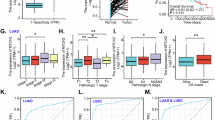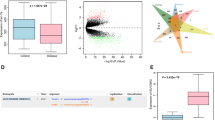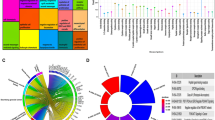Abstract
Following the identification of a set of hypoxia-regulated microRNAs (miRNAs), recent studies have highlighted the importance of miR-210 and of its transcriptional regulation by the transcription factor hypoxia-inducible factor-1 (HIF-1). We report here that miR-210 is overexpressed at late stages of non-small cell lung cancer. Expression of miR-210 in lung adenocarcinoma A549 cells caused an alteration of cell viability associated with induction of caspase-3/7 activity. miR-210 induced a loss of mitochondrial membrane potential and the apparition of an aberrant mitochondrial phenotype. The expression profiling of cells overexpressing miR-210 revealed a specific signature characterized by enrichment for transcripts related to ‘cell death’ and ‘mitochondrial dysfunction’, including several subunits of the electron transport chain (ETC) complexes I and II. The transcript coding for one of these ETC components, SDHD, subunit D of succinate dehydrogenase complex (SDH), was validated as a bona fide miR-210 target. Moreover, SDHD knockdown mimicked miR-210-mediated mitochondrial alterations. Finally, miR-210-dependent targeting of SDHD was able to activate HIF-1, in line with previous studies linking loss-of-function SDH mutations to HIF-1 activation. miR-210 can thus regulate mitochondrial function by targeting key ETC component genes with important consequences on cell metabolism, survival and modulation of HIF-1 activity. These observations help explain contradictory data regarding miR-210 expression and its putative function in solid tumors.
Similar content being viewed by others
Log in or create a free account to read this content
Gain free access to this article, as well as selected content from this journal and more on nature.com
or
Abbreviations
- Δψm:
-
mitochondrial membrane potential
- ETC:
-
electron transport chain
- HIF-1:
-
hypoxia-inducible factor-1
- HRE:
-
hypoxia-responsive element
- LNA:
-
locked nucleic acid
- miRISC:
-
miRNA-induced silencing complex
- miRNA:
-
microRNA
- NDUFA4:
-
NADH dehydrogenase (ubiquinone) 1 alpha subcomplex, 4
- NSCLCs:
-
non-small cell lung carcinomas
- PHD:
-
HIF prolyl hydroxylase domain proteins
- SDH:
-
succinate dehydrogenase
- SDHD:
-
succinate dehydrogenase complex, subunit D
- UTR:
-
untranslated region
- VHL:
-
von Hippel-Lindau
- XTT:
-
2, 3-bis(2-methoxy-4-nitro-5-sulfophenyl)-2H-tetrazolium-5-carboxanilide
References
Harpole DH Jr . Prognostic modeling in early stage lung cancer: an evolving process from histopathology to genomics. Thorac Surg Clin 2007; 17: 167–173, viii.
Lu J, Getz G, Miska EA, Alvarez-Saavedra E, Lamb J, Peck D et al. MicroRNA expression profiles classify human cancers. Nature 2005; 435: 834–838.
Volinia S, Calin GA, Liu CG, Ambs S, Cimmino A, Petrocca F et al. A microRNA expression signature of human solid tumors defines cancer gene targets. Proc Natl Acad Sci USA 2006; 103: 2257–2261.
Ortholan C, Puissegur MP, Ilie M, Barbry P, Mari B, Hofman P . MicroRNAs and lung cancer: new oncogenes and tumor suppressors, new prognostic factors and potential therapeutic targets. Curr Med Chem 2009; 16: 1047–1061.
Bartel DP . MicroRNAs: target recognition and regulatory functions. Cell 2009; 136: 215–233.
Grimson A, Farh KK, Johnston WK, Garrett-Engele P, Lim LP, Bartel DP . MicroRNA targeting specificity in mammals: determinants beyond seed pairing. Mol Cell 2007; 27: 91–105.
Lim LP, Lau NC, Garrett-Engele P, Grimson A, Schelter JM, Castle J et al. Microarray analysis shows that some microRNAs downregulate large numbers of target mRNAs. Nature 2005; 433: 769–773.
van Dongen S, Abreu-Goodger C, Enright AJ . Detecting microRNA binding and siRNA off-target effects from expression data. Nat Methods 2008; 5: 1023–1025.
Pottier N, Maurin T, Chevalier B, Puissegur MP, Lebrigand K, Robbe-Sermesant K et al. Identification of keratinocyte growth factor as a target of microRNA-155 in lung fibroblasts: implication in epithelial-mesenchymal interactions. PLoS One 2009; 4: e6718.
Camps C, Buffa FM, Colella S, Moore J, Sotiriou C, Sheldon H et al. hsa-miR-210 is induced by hypoxia and is an independent prognostic factor in breast cancer. Clin Cancer Res 2008; 14: 1340–1348.
Giannakakis A, Sandaltzopoulos R, Greshock J, Liang S, Huang J, Hasegawa K et al. miR-210 links hypoxia with cell cycle regulation and is deleted in human epithelial ovarian cancer. Cancer Biol Ther 2008; 7: 255–264.
Huang X, Ding L, Bennewith KL, Tong RT, Welford SM, Ang KK et al. Hypoxia-inducible mir-210 regulates normoxic gene expression involved in tumor initiation. Mol Cell 2009; 35: 856–867.
Foekens JA, Sieuwerts AM, Smid M, Look MP, de Weerd V, Boersma AW et al. Four miRNAs associated with aggressiveness of lymph node-negative, estrogen receptor-positive human breast cancer. Proc Natl Acad Sci USA 2008; 105: 13021–13026.
Greither T, Grochola LF, Udelnow A, Lautenschlager C, Wurl P, Taubert H . Elevated expression of microRNAs 155, 203, 210 and 222 in pancreatic tumors is associated with poorer survival. Int J Cancer 2009; 126: 73–80.
Zhang Z, Sun H, Dai H, Walsh RM, Imakura M, Schelter J et al. MicroRNA miR-210 modulates cellular response to hypoxia through the MYC antagonist MNT. Cell Cycle 2009; 8: 2756–2768.
Kulshreshtha R, Ferracin M, Wojcik SE, Garzon R, Alder H, Agosto-Perez FJ et al. A microRNA signature of hypoxia. Mol Cell Biol 2007; 27: 1859–1867.
Fasanaro P, D’Alessandra Y, Di Stefano V, Melchionna R, Romani S, Pompilio G et al. MicroRNA-210 modulates endothelial cell response to hypoxia and inhibits the receptor tyrosine kinase ligand Ephrin-A3. J Biol Chem 2008; 283: 15878–15883.
Chan SY, Zhang YY, Hemann C, Mahoney CE, Zweier JL, Loscalzo J . MicroRNA-210 controls mitochondrial metabolism during hypoxia by repressing the iron-sulfur cluster assembly proteins ISCU1/2. Cell Metab 2009; 10: 273–284.
Triboulet R, Mari B, Lin YL, Chable-Bessia C, Bennasser Y, Lebrigand K et al. Suppression of microRNA-silencing pathway by HIV-1 during virus replication. Science 2007; 315: 1579–1582.
Yanaihara N, Caplen N, Bowman E, Seike M, Kumamoto K, Yi M et al. Unique microRNA molecular profiles in lung cancer diagnosis and prognosis. Cancer Cell 2006; 9: 189–198.
Giatromanolaki A, Koukourakis MI, Sivridis E, Pastorek J, Wykoff CC, Gatter KC et al. Expression of hypoxia-inducible carbonic anhydrase-9 relates to angiogenic pathways and independently to poor outcome in non-small cell lung cancer. Cancer Res 2001; 61: 7992–7998.
Ilie M, Mazure NM, Hofman V, Ammadi RE, Ortholan C, Bonnetaud C et al. High levels of carbonic anhydrase IX in tumour tissue and plasma are biomarkers of poor prognostic in patients with non-small cell lung cancer. Br J Cancer 2010; 102: 1627–1635.
Buffa FM, Harris AL, West CM, Miller CJ . Large meta-analysis of multiple cancers reveals a common, compact and highly prognostic hypoxia metagene. Br J Cancer 2010; 102: 428–435.
Favaro E, Ramachandran A, McCormick R, Gee H, Blancher C, Crosby M et al. MicroRNA-210 regulates mitochondrial free radical response to hypoxia and krebs cycle in cancer cells by targeting iron sulfur cluster protein ISCU. PLoS One 2010; 5: e10345.
Tazawa H, Tsuchiya N, Izumiya M, Nakagama H . Tumor-suppressive miR-34a induces senescence-like growth arrest through modulation of the E2F pathway in human colon cancer cells. Proc Natl Acad Sci USA 2007; 104: 15472–15477.
Le Brigand K, Russell R, Moreilhon C, Rouillard JM, Jost B, Amiot F et al. An open-access long oligonucleotide microarray resource for analysis of the human and mouse transcriptomes. Nucleic Acids Res 2006; 34: e87.
Gimenez-Roqueplo AP, Favier J, Rustin P, Mourad JJ, Plouin PF, Corvol P et al. The R22X mutation of the SDHD gene in hereditary paraganglioma abolishes the enzymatic activity of complex II in the mitochondrial respiratory chain and activates the hypoxia pathway. Am J Hum Genet 2001; 69: 1186–1197.
Dahia PL, Ross KN, Wright ME, Hayashida CY, Santagata S, Barontini M et al. A HIF1alpha regulatory loop links hypoxia and mitochondrial signals in pheochromocytomas. PLoS Genet 2005; 1: 72–80.
Fasanaro P, Greco S, Lorenzi M, Pescatori M, Brioschi M, Kulshreshtha R et al. An integrated approach for experimental target identification of hypoxia-induced miR-210. J Biol Chem 2009; 284: 35134–35143.
Gottlieb E, Tomlinson IP . Mitochondrial tumour suppressors: a genetic and biochemical update. Nat Rev Cancer 2005; 5: 857–866.
Chen Z, Li Y, Zhang H, Huang P, Luthra R . Hypoxia-regulated microRNA-210 modulates mitochondrial function and decreases ISCU and COX10 expression. Oncogene 2010; 29: 4362–4368.
Semenza GL . Oxygen-dependent regulation of mitochondrial respiration by hypoxia-inducible factor 1. Biochem J 2007; 405: 1–9.
Kulshreshtha R, Davuluri RV, Calin GA, Ivan M . A microRNA component of the hypoxic response. Cell Death Differ 2008; 15: 667–671.
Denko NC . Hypoxia, HIF1 and glucose metabolism in the solid tumour. Nat Rev Cancer 2008; 8: 705–713.
King A, Selak MA, Gottlieb E . Succinate dehydrogenase and fumarate hydratase: linking mitochondrial dysfunction and cancer. Oncogene 2006; 25: 4675–4682.
Kaelin WG . The von Hippel-Lindau tumor suppressor protein: roles in cancer and oxygen sensing. Cold Spring Harb Symp Quant Biol 2005; 70: 159–166.
Selak MA, Armour SM, MacKenzie ED, Boulahbel H, Watson DG, Mansfield KD et al. Succinate links TCA cycle dysfunction to oncogenesis by inhibiting HIF-alpha prolyl hydroxylase. Cancer Cell 2005; 7: 77–85.
Richard DE, Berra E, Gothie E, Roux D, Pouyssegur J . p42/p44 mitogen-activated protein kinases phosphorylate hypoxia-inducible factor 1alpha (HIF-1alpha) and enhance the transcriptional activity of HIF-1. J Biol Chem 1999; 274: 32631–32637.
Griffiths-Jones S . miRBase: the microRNA sequence database. Methods Mol Biol 2006; 342: 129–138.
Le Brigand K, Barbry P . Mediante: a web-based microarray data manager. Bioinformatics 2007; 23: 1304–1306.
Acknowledgements
We acknowledge the excellent support of the Nice-Sophia Antipolis Functional Genomics Platform and of the ‘Centre Commun de Microscopie Appliquée’ from the University of Nice-Sophia-Antipolis. We thank Fredéric Brau and Julie Cazareth (Imaging Platform of IPMC, Sophia-Antipolis), Nicolas Pons (IPMC) and Karine Ilc (Centre Antoine Lacassagne, Nice) for excellent technical assistance concerning microscopy, flow cytometry experiments and IHC. We acknowledge Pr Mouroux and Pr Vénissac (Department of Thoracic Surgery, Pasteur Hospital, CHU of Nice, France) for providing us with surgical lung specimens, and Mr Eric Selva and Ms Virginie Tanga-Gavric (Human Biobank, CHU of Nice) for excellent technical assistance. We thank Patrick Auberger, Brice Marcet and Patricia LM Dahia for helpful discussion and Ms Christiane Brahimi-Horn for critical reading and editorial correction of the paper. This work was supported by the Association pour la Recherche contre le Cancer (ARC post-doctoral Fellowship to MPP and Grant no. 1122 to JER), Cancéropole PACA (PB, PH and BM), INCa (PL0079, PB), European Community's Seventh Framework Program FP7/2007-2011 under grant agreement number 201279 (to KR, KL, SF, PB and BM) and METOXIA FP7 (to NMM and JP), and PHRC Grant 2003 CHU Nice (to BM, PB, KL, VH and PH).
Author information
Authors and Affiliations
Corresponding authors
Ethics declarations
Competing interests
The authors declare no conflict of interest.
Additional information
Edited by B Zhivotovsky
Supplementary Information accompanies the paper on Cell Death and Differentiation website
Supplementary information
Rights and permissions
About this article
Cite this article
Puisségur, MP., Mazure, N., Bertero, T. et al. miR-210 is overexpressed in late stages of lung cancer and mediates mitochondrial alterations associated with modulation of HIF-1 activity. Cell Death Differ 18, 465–478 (2011). https://doi.org/10.1038/cdd.2010.119
Received:
Revised:
Accepted:
Published:
Issue date:
DOI: https://doi.org/10.1038/cdd.2010.119
Keywords
This article is cited by
-
PDGF-BB accelerates TSCC via fibroblast lactates limiting miR-26a-5p and boosting mitophagy
Cancer Cell International (2024)
-
CD204-positive M2-like tumor-associated macrophages increase migration of gastric cancer cells by upregulating miR-210 to reduce NTN4 expression
Cancer Immunology, Immunotherapy (2024)
-
Recent advances on high-efficiency of microRNAs in different types of lung cancer: a comprehensive review
Cancer Cell International (2023)
-
Gene expression related to lung cancer altered by PHMG-p treatment in PBTE cells
Molecular & Cellular Toxicology (2023)
-
MicroRNA-21 guide and passenger strand regulation of adenylosuccinate lyase-mediated purine metabolism promotes transition to an EGFR-TKI-tolerant persister state
Cancer Gene Therapy (2022)



